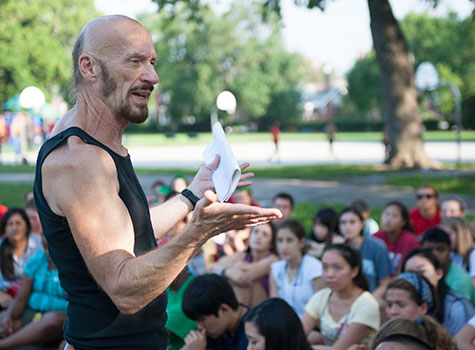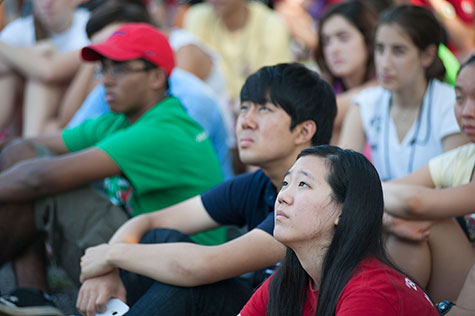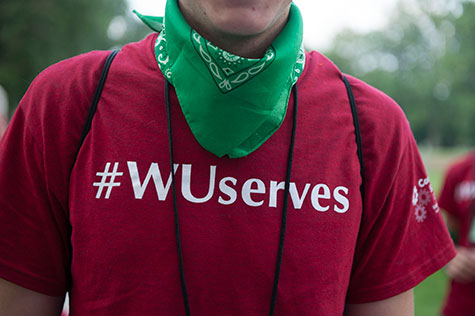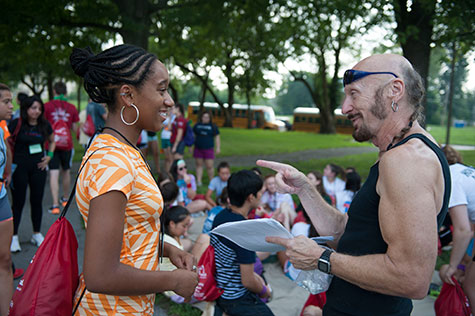
It’s 10 a.m., and Bob Hansman is on a bus addressing students, brandishing a St. Louis guidebook like a prosecutor at trial.
“Today isn’t this,” he growls. “Get ready.”
Since the Aug. 9 shooting of unarmed teenager Michael Brown, the eyes of the world have turned to the St. Louis suburb of Ferguson, Mo. Hansman, associate professor in the Sam Fox School of Design & Visual Arts at Washington University in St. Louis — and one of the area’s most prominent community activists — is passionate about the case but has avoided the surrounding violence and media spectacle.
Instead, over the last two weeks, Hansman has quietly ushered hundreds of students through the neighborhoods of north St. Louis. Along the way, he chronicles the dismal racial, social and urban histories that have shaped conditions on the ground, but also introduces the ministers, shop owners and longtime residents who persevere in calling the north side home.
“My role in life is to bring together people who might not meet any other way,” he says. “The misconceptions, on all sides, are astonishing.”
You begin at the South Ewing overpass, overlooking Highway 40, a couple miles west of the Gateway Arch. It’s a barren spot. Why here?
Almost everything you see, from Grand Avenue to the Union Station exit, was once part of Mill Creek Valley. During the Great Migration, it was one of the two great African-American neighborhoods in St. Louis, along with The Ville. But in the 1950s, the city decided Mill Creek was a slum and tore most of it down to make room for the highway.
That decision changed the structure of the city. It was also the start of public housing in St. Louis. Once you demolish all those buildings, where do you put the people?

One answer to that question was Pruitt-Igoe, the infamous 33-building complex that opened in the mid-1950s and was demolished 20 years later.
Pruitt-Igoe is everybody’s whipping boy. Some say it was an architectural failing. Some say it was the economy. Some blame the people themselves. Some say it was the fault of government, which reluctantly built public housing but left no funding mechanism.
Whoever you blame, Pruitt-Igoe was a social experiment disaster. Everything was torn down. What’s left is one of the strangest urban landscapes you’ll ever see — a kind of scrubby natural forest that’s grown up over the last 30 years.
Walking the site today, you notice lots of construction debris. Are those remnants of the buildings?
No. The site was completely cleared. The debris is from illegal dumping.
I call my tours “Understanding What We See.” It’s about connecting here and there, then and now. When you look at a particular instance, you also need to have the larger picture.
The tours are also about understanding how structural conditions shape what might seem like individual decisions. I grew up white in the suburbs. My son (Jovan, whom Hansman adopted in 2001) grew up black in the projects. To say we had the same choices is crazy.

As founder of City Faces, which Jovan now directs, you’ve spent more than 20 years in some of the city’s roughest neighborhoods, teaching kids to draw. Talk about that.
It all started with some kids on my back porch near McRee Town. Even that first day in Clinton-Peabody (the housing project where City Faces has been based since 1994) I just showed up with some drawing tablets. I didn’t set out to start a program. You see a need and address it.
At first, part of me was surprised that any of these kids, with all the issues in their lives, would care about drawing. It seemed … luxurious. But then I thought, why should these kids — just because they’re poor — have any less need for self-expression and transcendence? Maybe they need it more.
It’s funny — many people still think of City Faces as an art program, but I don’t. It’s a life program. It’s mentoring and tutoring and talking about problems. It’s cooking classes and safety classes. Sometimes it’s about going to court and speaking on their behalf. It’s all those things.
You get a lot of college students volunteering with City Faces — as many as 30 or 40 at a time. What advice do you give them?
Don’t insist. Don’t come in with your lesson plan and say, “Today we’re going to do this.” Just sit down and start doing something. Let it happen naturally. The kids will ask, “What are you doing? Show me how.”
Then it’s their idea, and that just changes everything.
